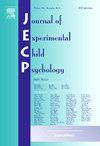儿童短期记忆的加工顺序存在空间偏倚。
IF 1.8
2区 心理学
Q3 PSYCHOLOGY, DEVELOPMENTAL
引用次数: 0
摘要
当处理序列信息时,成年人倾向于按照他们的阅读和写作系统的方向,将序列的元素映射到心理的水平线上。例如,在西方人中,一个系列的开始与思维线的左边有关,而它的结束则优先与右边有关。为了完成少数调查这种空间偏差的文化与先天决定因素的研究,当前的研究使用了未标记序列信息的旋转任务。实验1测量了从蹒跚学步到五年级(2到12岁)的儿童以及成人中向左偏倚的存在。结果仅显示在成人中存在偏差。实验2的设计是为了避免在实验1中发现的潜在混淆,实验3为参与者提供了更明确的信息,但结果仍然没有显示出明显的儿童向左偏倚。通过控制实验4中材料的心理旋转,我们最终观察到在各个年龄组中,特别是在二年级(7岁)和四年级(9岁)之间,以及成年人中,出现了从左到右的整体偏倚。总的来说,这项研究表明,在成人中观察到的空间-顺序关联也可以在儿童中观察到,早在小学。此外,在年龄较小的儿童中观察到较弱的偏见,这表明这种影响可能在学龄前(4岁)开始出现,然后在后来的识字专业知识中得到加强。本文章由计算机程序翻译,如有差异,请以英文原文为准。
Processing order in short-term memory is spatially biased in children
When processing serial information, adults tend to map elements of a sequence onto a mental horizontal line, following the direction of their reading and writing system. For example, in a Western population, the beginning of a series is associated with the left-hand side of the mental line, while its end is preferentially associated with the right. To complete the few studies that have investigated the cultural vs. innate determinants of such a spatial bias, the current study used a rotation task of unlabeled serial information. Experiment 1 measured the presence of a left-oriented bias in children from toddlers to grade 5 (aged 2 to 12 years old) and in adults. Results only showed a bias in adults. Experiment 2 was designed to avoid potential confounds identified in Experiment 1, and Experiment 3 provided more explicit information to participants, but the results still did not show a clear left-oriented bias in children. By controlling the mental rotation of our material in Experiment 4, we finally observed a global left-to-right bias across age groups, in particular between the grade (7 years old) and the grade (9 years old), and in adults. Overall, this study shows that spatial-ordinal associations observed in adults can also be observed in children as early as primary school. In addition, a weaker bias was observed in younger children, which suggests that the effect could begin to emerge in preschool (4 years old) before being reinforced later with expertise in literacy.
求助全文
通过发布文献求助,成功后即可免费获取论文全文。
去求助
来源期刊

Journal of Experimental Child Psychology
Multiple-
CiteScore
4.50
自引率
7.70%
发文量
190
期刊介绍:
The Journal of Experimental Child Psychology is an excellent source of information concerning all aspects of the development of children. It includes empirical psychological research on cognitive, social/emotional, and physical development. In addition, the journal periodically publishes Special Topic issues.
 求助内容:
求助内容: 应助结果提醒方式:
应助结果提醒方式:


